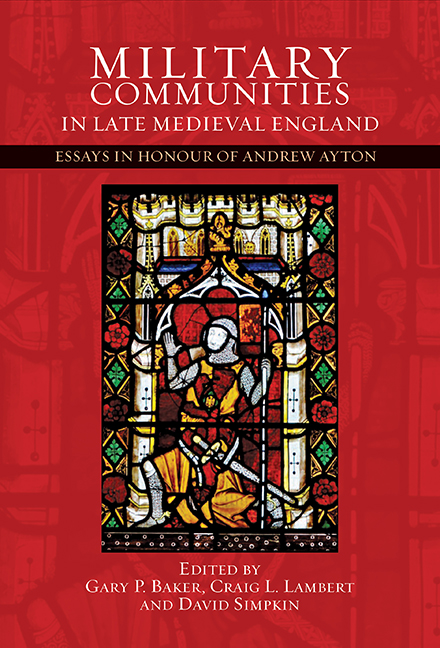Book contents
- Frontmatter
- Miscellaneous Frontmatter
- Contents
- List of Illustrations
- Acknowledgements
- List of Contributors
- Foreword
- Andrew Ayton: A Brief Tribute
- Andrew Ayton: A Recognition of his Work
- Abbreviations
- Part Title
- 1 ‘Big and Beautiful’. Destriers in Edward I's Armies
- 2 Cum Equis Discoopertis: The ‘Irish’ Hobelar in the English Armies of the Fourteenth Century
- 3 Andrew Ayton, the Military Community and the Evolution of the Gentry in Fourteenth-Century England
- 4 Knights Banneret, Military Recruitment and Social Status, c. 1270–c. 1420: A View from the Reign of Edward I
- 5 Sir Henry de Beaumont and His Retainers: The Dynamics of a Lord's Military Retinues and Affinity in Early Fourteenth-Century England
- 6 Financing the Dynamics of Recruitment: King, Earls and Government in Edwardian England, 1330–60
- 7 The Symbolic Meaning of Edward III's Garter Badge
- 8 Sir Robert Knolles’ Expedition to France in 1370: New Perspectives
- 9 The Organisation and Financing of English Expeditions to the Baltic during the Later Middle Ages
- 10 Naval Service and the Cinque Ports, 1322–1453
- 11 The Garrison Establishment in Lancastrian Normandy in 1436 according to Surviving Lists in Bibliothèque Nationale de France manuscrit français 25773
- Bibliography of the Writings of Andrew Ayton
- Index
- Tabula Gratulatoria
- Warfare in History
7 - The Symbolic Meaning of Edward III's Garter Badge
from Part Title
Published online by Cambridge University Press: 17 July 2019
- Frontmatter
- Miscellaneous Frontmatter
- Contents
- List of Illustrations
- Acknowledgements
- List of Contributors
- Foreword
- Andrew Ayton: A Brief Tribute
- Andrew Ayton: A Recognition of his Work
- Abbreviations
- Part Title
- 1 ‘Big and Beautiful’. Destriers in Edward I's Armies
- 2 Cum Equis Discoopertis: The ‘Irish’ Hobelar in the English Armies of the Fourteenth Century
- 3 Andrew Ayton, the Military Community and the Evolution of the Gentry in Fourteenth-Century England
- 4 Knights Banneret, Military Recruitment and Social Status, c. 1270–c. 1420: A View from the Reign of Edward I
- 5 Sir Henry de Beaumont and His Retainers: The Dynamics of a Lord's Military Retinues and Affinity in Early Fourteenth-Century England
- 6 Financing the Dynamics of Recruitment: King, Earls and Government in Edwardian England, 1330–60
- 7 The Symbolic Meaning of Edward III's Garter Badge
- 8 Sir Robert Knolles’ Expedition to France in 1370: New Perspectives
- 9 The Organisation and Financing of English Expeditions to the Baltic during the Later Middle Ages
- 10 Naval Service and the Cinque Ports, 1322–1453
- 11 The Garrison Establishment in Lancastrian Normandy in 1436 according to Surviving Lists in Bibliothèque Nationale de France manuscrit français 25773
- Bibliography of the Writings of Andrew Ayton
- Index
- Tabula Gratulatoria
- Warfare in History
Summary
One of Andrew Ayton's many contributions to his field is the way he helped both his own and the next generation of historians appreciate that, as Nigel Saul puts it in his foreword to this volume, an Edwardian army ‘was held together by the social authority and resources of its principal commander’, and that ‘in the field, the force's effectiveness would depend largely on the individual commander's authority and on the day-to-day relations between his immediate lieutenants’. As Richard Barber has emphasised, Edward III consciously used his immense social and chivalric authority to foster powerful bonds of affection and mutual understanding with and among his principal military captains, and one of the most important means he employed to that end was the creation of a new chivalric order in 1348.
Britain's ‘Most Noble Order of the Garter’ is the oldest, most famous, and most prestigious of all the monarchical orders of knighthood. The buckled blue band with its gold motto of honi soit qui mal y pense (‘shamed be he who thinks ill of it’) has become part of the royal arms of the United Kingdom, and can be seen in countless places in Britain and the Commonwealth as a result. Knights and Ladies of the Order are entitled to display their own heraldic arms encircled by the Garter, and for this reason also, many garter-emblems can be found in churches, colleges, hospitals and other public structures throughout Britain and across the world.
When they first encounter the garter symbol and motto, students and tourists often react with some puzzlement. To twenty-first-century sensibilities, a garter seems a strange choice for a chivalric emblem, while the motto naturally provokes the question ‘who thinks ill of what?’ Efforts to satisfy the curiosity aroused by the heraldry of the Order have not been lacking. According to an oft-told story, of which there are several variations, King Edward retrieved a garter that slipped from a lady's leg at a ball, and pronounced the motto as a gentlemanly effort to shield her from embarrassment. The earliest version of this tale, however, was first published in the 1460s, and has no foundation whatsoever in any source even close to contemporary with the Order's establishment.
- Type
- Chapter
- Information
- Military Communities in Late Medieval EnglandEssays in Honour of Andrew Ayton, pp. 125 - 146Publisher: Boydell & BrewerPrint publication year: 2018



